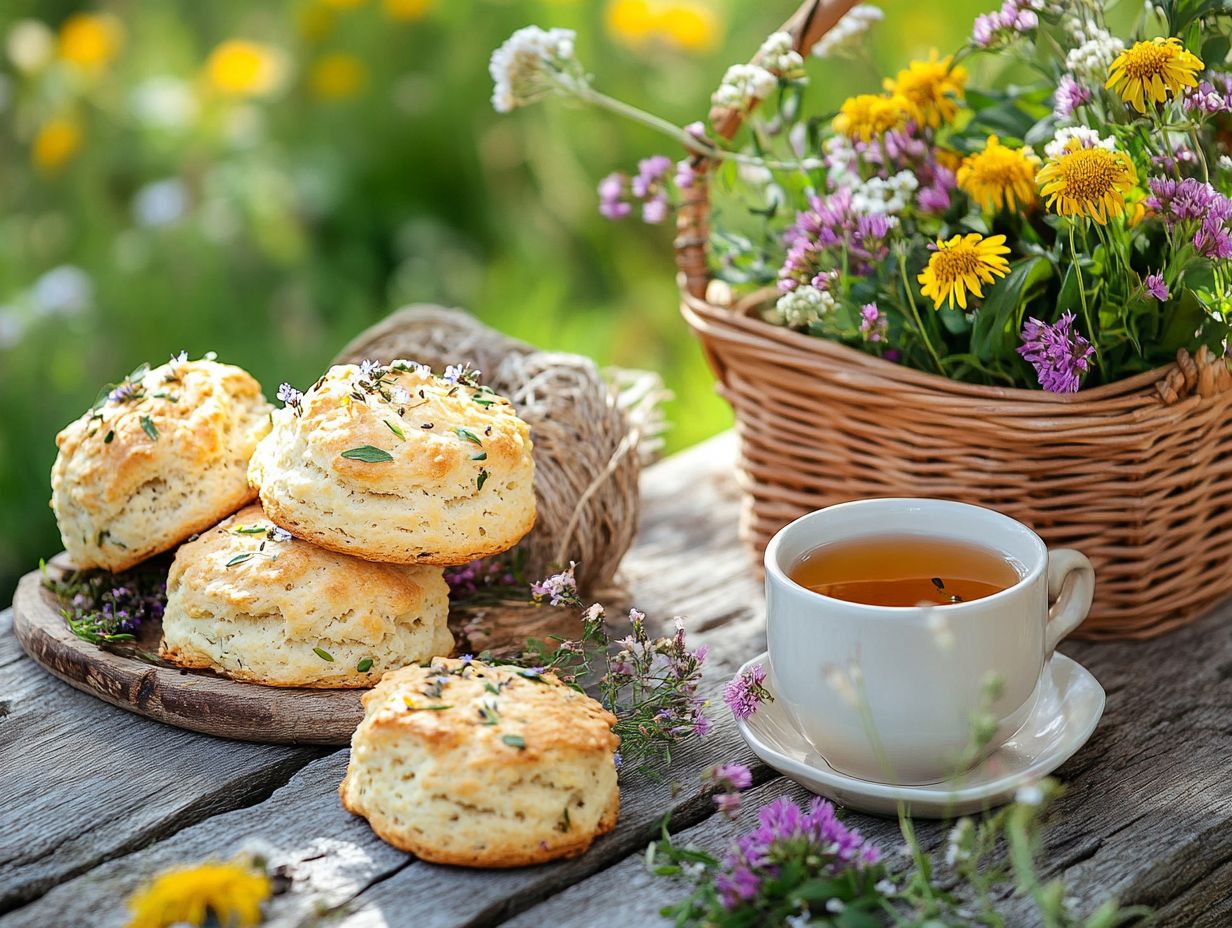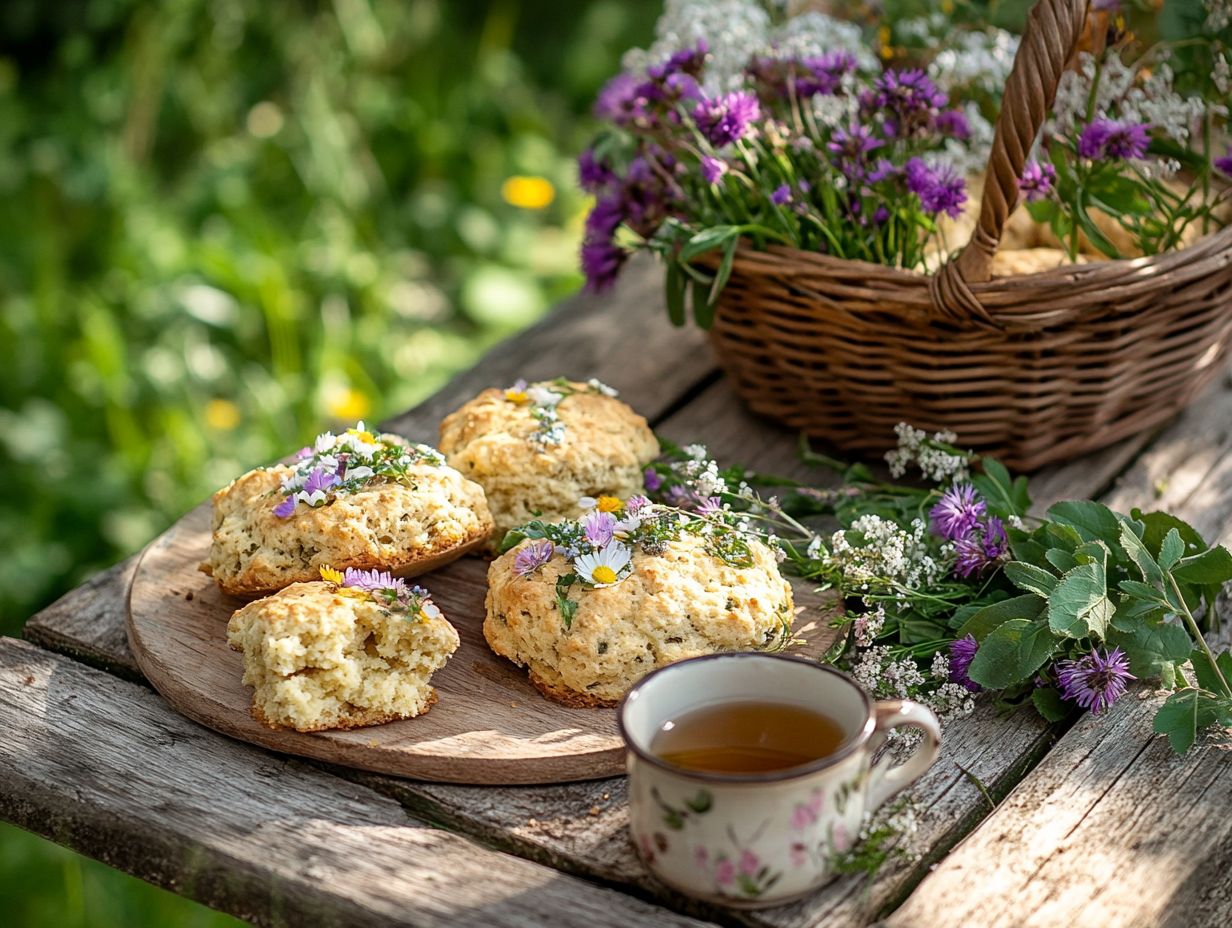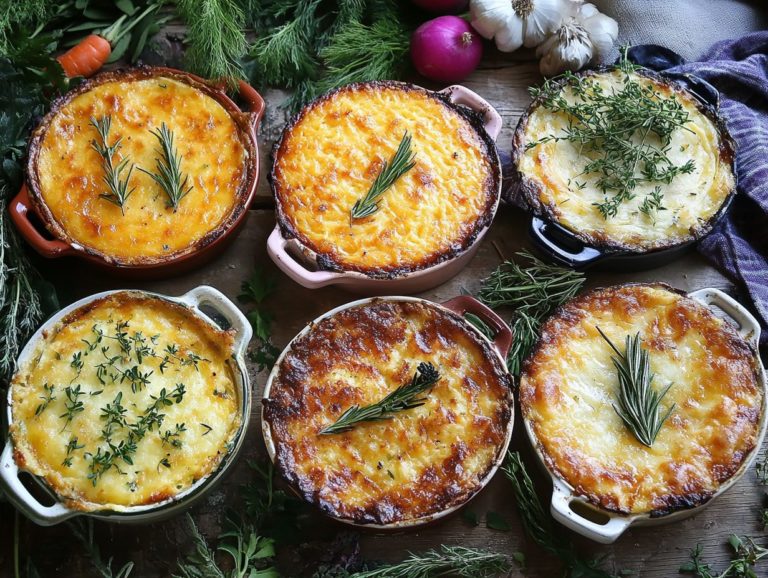How to Make Wild Edible Scones
Wild edibles are nature’s hidden gems, ready to add a delightful twist to your culinary creations. Explore the myriad benefits of incorporating these nutritious plants into your cooking, emphasizing sustainability and their remarkable nutritional value.
You ll learn to identify and ethically harvest wild edibles, ensuring a safe and rewarding foraging experience. Plus, you’ll discover a scrumptious recipe for wild edible scones, complete with tips for perfecting your baking and creating unique flavors.
Prepare to elevate your kitchen adventures to new heights!
Contents
- Key Takeaways:
- Benefits of Using Wild Edibles in Cooking
- Identifying and Harvesting Wild Edibles
- Recipe for Wild Edible Scones
- Tips for Baking with Wild Edibles
- Frequently Asked Questions
- What are wild edible scones?
- How do I find wild edible ingredients for my scones?
- What types of wild ingredients can I use in my scones?
- Can I substitute wild ingredients with store-bought ingredients?
- Do I need any special equipment to make wild edible scones?
- What are some tips for making perfect wild edible scones?
Key Takeaways:

- Incorporating wild edibles into your cooking can provide nutritional benefits and promote sustainability.
- When foraging for wild edibles, always follow safe and ethical practices to protect both yourself and the environment.
- Get creative with flavor combinations and substitutions when using wild edibles in baking, such as adding wild berries or using wild herbs as a replacement for traditional spices like ground wattleseed.
What are Wild Edibles?
Wild edibles encompass a fascinating array of plants, fungi, and herbs that thrive naturally in your environment, offering a sustainable source of local food. Often overlooked, these local plants are rich in flavor and nutrients, making them a delightful addition to any meal you create.
Foraging for wild edibles connects you with nature and supports seasonal eating. You might find wild garlic, brambles, and various greens that can elevate your traditional recipes.
Alongside wild garlic, celebrated for its vibrant flavor, you ll discover dandelion greens, nettles, and mushrooms like chanterelles, each waiting to be discovered. Each of these foraged gems carries a unique set of health benefits, brimming with vitamins, minerals, and antioxidants.
By incorporating ingredients like wild brambles and wild garlic butter into your meals, you diversify your palate while cultivating a deeper appreciation for the local ecosystems around you. Understanding the importance of foraging nurtures sustainable culinary practices and reminds you to honor the earth’s natural bounty.
Benefits of Using Wild Edibles in Cooking
Utilizing wild edibles in your culinary creations presents an array of benefits. They elevate both the nutritional content and flavor profiles of your dishes. By incorporating these indigenous natural foods, you cultivate a connection to local food systems and champion sustainability.
Ingredients like wild garlic and wild brambles introduce distinctive flavors and deliver essential nutrients. Transform your meals into nourishing and delightful experiences that celebrate local food.
Nutritional Value and Sustainability
The nutritional value of wild edibles is remarkable, often surpassing that of cultivated varieties in vitamins, minerals, and antioxidants. Take wild garlic; it delivers robust flavors along with a host of health benefits.
Consider stinging nettles, frequently overlooked yet brimming with iron and vitamin K; they are a powerhouse for boosting energy and promoting bone health. Dandelion greens, rich in calcium and antioxidants, play a significant role in a balanced diet and demonstrate commitment to protecting the variety of life in our environment.
When foraging, it is essential to approach these resources with respect. Responsible harvesting allows for natural regeneration while safeguarding the delicate balance of local habitats. This mindful approach not only protects the environment but also fosters a deeper connection to nature, vital for cultivating a sustainable relationship with our food sources.
Start your foraging journey today and discover the flavors of nature!
Identifying and Harvesting Wild Edibles

Identifying and harvesting wild edibles is an essential skill for any forager. This practice requires knowledge and respect for nature’s bounty.
Immerse yourself in the local flora. Understand growth patterns and learn to recognize the characteristics of edible plants like wild garlic and brambles.
Ethical foraging practices safeguard the long-term health of these plants. They also promote the variety of plants and animals in the environment, encouraging responsible consumption in your culinary pursuits.
Safe and Ethical Foraging Practices
Practicing safe and ethical foraging is crucial for anyone seeking to collect wild edibles responsibly. You need to understand your local ecosystem and follow regulations regarding foraging.
By prioritizing safety and ethical practices, you can enjoy delicious local food like wild garlic while preserving the natural environment for future generations.
Identifying sustainable foraging locations is essential. It helps maintain the delicate balance of these ecosystems. Educating yourself on which species are native and abundant allows for responsible harvesting without depleting resources.
Remember, leaving plants unharmed is key. Overharvesting can lead to ecological consequences that threaten both plant populations and the wildlife that depends on them.
Understand local laws that govern foraging, as regulations differ widely. Some areas might require permits or offer protection for certain species. Adopting a thoughtful approach to foraging not only benefits you but also fosters a deeper respect for nature itself.
Recipe for Wild Edible Scones
Creating wild edible scones offers a delightful opportunity to weave the flavors of foraged ingredients into your baking repertoire. This exquisite recipe marries the distinctive taste of wild garlic with wholesome traditional methods, allowing you to craft both savory and sweet variations.
You can include cheddar cheese for a comforting twist or modify the recipe for delightful vegan scones. This dish truly celebrates nature’s bounty, transforming it into an accessible and delicious experience for your palate.
Ingredients and Step-by-Step Instructions
To prepare wild edible scones, gather these ingredients:
- Fresh wild garlic
- Flour
- Milk
- Egg
This combination creates a delightful dough that s easily shaped and baked into golden scones. Just follow these step-by-step instructions to ensure each batch is perfectly baked and infused with the essence of local food and seasonal sustenance.
Beyond the essentials, consider adding a sprinkle of salt for balance and a hint of baking powder to ensure your scones rise beautifully. Incorporating wild herbs like nettles or dandelion greens will not only enhance flavor but also elevate the nutritional value.
-
Start by preheating your oven to 400 F (200 C). In a mixing bowl, combine the flour, baking powder, and salt. Cut in your cold butter until the mixture resembles coarse crumbs.
-
Next, gently fold in the chopped wild garlic and any other selected herbs. Make a well in the center, whisk together the egg and milk, and pour this into the dry mix, stirring just until combined. Be careful not to overwork the dough; otherwise, you might end up with tough scones.
-
Once you’ve shaped your dough into rounds, place them on a prepared baking sheet and bake for 15-20 minutes until they re golden brown. For that extra touch of indulgence, a light brush of melted butter before serving will elevate these wild scones to new heights.
Tips for Baking with Wild Edibles

Baking with wild edibles invites you into a realm of cooking creativity, where you can discover unique flavor combinations and elevate your comfort food creations.
When working with ingredients like delightful wild garlic, it s vital to grasp how to harness their bold flavors in your recipes. By embracing tips for substitutions and techniques to enhance natural flavors, you can transform your baked goods and truly celebrate the essence of local and indigenous ingredients.
Discover wild edibles today and bring home a taste of nature!
Get started on your wild foraging adventure now and taste the difference!
Substitutions and Flavor Combinations
When you bake with wild edibles, knowing which substitutions to make can truly elevate your dishes. Swapping traditional herbs for wild garlic adds a delightful twist to savory scones. Adding ground wattleseed gives your creations a unique taste that highlights local plants. Understanding these substitutions allows you to unleash your creativity in the kitchen, resulting in comfort food that delights the palate.
Picture this: foraged nettles in your classic quiche. They bring a subtle earthy flavor that perfectly balances richness and herbaceous notes. Don t miss the chance to use wild blueberries instead of regular ones. They boost sweetness and add a vibrant burst of color and nutrition to your dish. Consider blending foraged elderflower into your cake or muffin batters; it infuses a fragrant, floral essence that can transform even the most everyday recipes.
Explore these wild alternatives to craft dishes that are not only delicious but also tell a story of your environment. Make every bite a celebration of nature’s bounty.
Frequently Asked Questions
What are wild edible scones?
Wild edible scones are scones made with ingredients found in nature, such as wild berries, nuts, and herbs.
How do I find wild edible ingredients for my scones?

You can find wild edible ingredients by foraging in nature or purchasing them from a trusted source. Make sure to properly identify the plants before using them in your scones.
What types of wild ingredients can I use in my scones?
There are many types of wild ingredients that can be used in scones, including berries, nuts, flowers, and herbs. Popular choices include blueberries, hazelnuts, lavender, and rosemary.
Can I substitute wild ingredients with store-bought ingredients?
Yes, you can substitute wild ingredients with store-bought ingredients if necessary. However, the flavor and texture of the scones may differ from the original recipe.
Do I need any special equipment to make wild edible scones?
No, you do not need any special equipment to make wild edible scones. A mixing bowl, baking sheet, and oven are all you need to make delicious scones.
What are some tips for making perfect wild edible scones?
Some tips for making perfect wild edible scones include using fresh and properly identified ingredients, handling the dough gently, and following the recipe closely. For a delicious addition, consider incorporating wild edible trail mix into your creations. Experiment with different combinations of wild ingredients to find your favorite flavors.
Try these wild edible scone recipes today and taste the difference nature makes!






